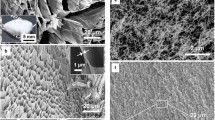Abstract
Aerogels are open-cell foams that have already been shown to be among the best thermal insulating solid materials known. This paper examines the three major contributions to thermal transport through porous materials, solid, gaseous, and radiative, to identify how to reduce the thermal conductivity of air-filled aerogels. We found that significant improvements in the thermal insulation property of aerogels are possible by (i) employing materials with a low intrinsic solid conductivity, (ii) reducing the average pore size within aerogels, and (iii) affecting an increase of the infrared extinction in aerogels. Theoretically, polystyrene is the best of the organic materials and zirconia is the best inorganic material to use for the lowest achievable conductivity. Significant reduction of the thermal conductivity for all aerogel varieties is predicted with only a modest decrease of the average pore size. This might be achieved by modifying the sol-gel chemistry leading to aerogels. For example, a thermal resistance value of R = 20 per inch would be possible for an air-filled resorcinol-formaldehyde aerogel at a density of 156 kg/m3, if the average pore size was less than 35 nm. An equation is included which facilitates the calculation of the optimum density for the minimum total thermal conductivity, for all varieties of aerogels.
Similar content being viewed by others
References
Aerogels, Springer Proc. in Physics, edited by J. Fricke (Springer-Verlag, Heidelberg, Germany, 1986), Vol. 6.
J. Fricke and A. Emmerling, in Chemistry, Spectroscopy, and Applications of Sol-Gel Glasses, edited by R. Reisfeld and C. K. Jorgensen, Springer Series on Structure and Bonding (Springer-Verlag, Heidelberg, Germany, 1991), Vol. 77, p. 37.
R. Caps and J. Fricke, in Aerogels, Springer Proc. in Physics, edited by J. Fricke (Springer-Verlag, Heidelberg, Germany, 1986), Vol. 6, p. 104.
J.D. LeMay, R.W. Hopper, L.W. Hrubesh, and R.W. Pekala, MRS Bull. XV, 19 (1990).
X. Lu, M. C. Arduini-Schuster, J. Kuhn, O. Nilsson, J. Fricke, and R.W. Pekala, Science 255, 971 (1992).
J. Fricke, X. Lu, P. Wang, D. Buttner, and U. Heinemann, Int. J. Heat Mass Transfer 35, 2305 (1992).
J. Fricke, E. Hummer, H-J. Morper, and P. Scheuerpflug, in Revue de Physique Apliqueé, edited by R. Vacher, J. Phalippou, J. Pelous, and T. Woignier (Proc. 2nd Int. Symp. Aerogels 24, C4, Les Editions de Physique, Les Ulis Cedex, 1989), p. 87.
J. Gross, J. Fricke, and L. W. Hrubesh, J. Acoust. Soc. Am. 91 (4), 2004 (1992).
J. Gross and J. Fricke, J. Non-Cryst. Solids 145, 217 (1992).
The Oxide Handbook, edited by G. V. Samsonov (Plenum, New York, 1973).
D. W. Van Krevelen, Properties of Polymers (Elsevier, New York, 1990), p. 527.
J. Gross, J. Fricke, R.W. Pekala, and L.W. Hrubesh, Phys. Rev. B 45 (22), 775 (1992).
X. Lu, M. C. Arduini-Schuster, J. Kuhn, O. Nilsson, J. Fricke, and R.W. Pekala, Science 255, 974 (1992).
M. Kaviany, Principles of Heat Transfer in Porous Media (Springer-Verlag, New York, 1991), p. 333.
J. Fricke, X. Lu, P. Wang, D. Buttner, and U. Heinemann, Science 255, 2308 (1992).
F-M. Kong, S. S. Hulsey, C. T. Alviso, and R. W. Pekala, in Novel Forms of Carbon, edited by C. L. Renschler, J. J. Pouch, and D. M. Cox (Mater. Res. Soc. Symp. Proc. 270, Pittsburgh, PA, 1992), p. 15.
T.M. Tillotson, L.W. Hrubesh, and I.M. Thomas, in Better Ceramics Through Chemistry III, edited by C.J. Brinker, D.E. Clark, and D.R. Ulrich (Mater. Res. Soc. Symp. Proc. 121, Pittsburgh, PA, 1988), p. 685.
R. W. Pekala, J. Mater. Sci. 24, 3221 (1989).
R. Caps and J. Fricke, in Aerogels, Springer Proc. in Physics, edited by J. Fricke (Springer-Verlag, Heidelberg, Germany, 1986), Vol. 6, p. 110.
J. Fricke, in Aerogels, Springer Proc. in Physics, edited by J. Fricke (Springer-Verlag, Heidelberg, Germany, 1986), Vol. 6, p. 94.
M. Martin, Thermalux, Inc., private communication.
X. Lu, O. Nilsson, J. Fricke, and R. W. Pekala, J. Appl. Phys. 73, 581 (1993).
K. Kinoshita, Carbon—Electrochemical and Physicochemical Properties (John Wiley & Sons, New York, 1988), p. 12
Author information
Authors and Affiliations
Rights and permissions
About this article
Cite this article
Hrubesh, L.W., Pekala, R.W. Thermal properties of organic and inorganic aerogels. Journal of Materials Research 9, 731–738 (1994). https://doi.org/10.1557/JMR.1994.0731
Received:
Accepted:
Published:
Issue Date:
DOI: https://doi.org/10.1557/JMR.1994.0731




